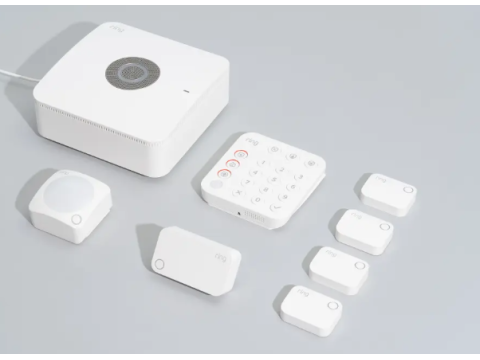Security alarm systems rely on intrusion detectors (often called security sensors) to sense threats like forced openings, glass breakage, drilling, or unauthorized movement. These sensors come in a wide variety of forms, each suited to specific applications: doors, windows, walls, or open areas. Below, we discuss the major types of security sensors, including their principles of operation, typical uses, and considerations for installation and wiring.
Sensor Types & Detection Principles
Security sensors (or intrusion detectors) are classified by:
How They Detect Intrusions:
- Non-destructive (opening a door or window)
- Destructive (breaking a window, drilling or smashing a wall)
- Movement (occupancy or motion in a protected area)
Underlying Physics:
- Magnetic (reed switches)
- Infrared (IR)
- Microwave or Ultrasonic
- Acoustic
- Vibration
Construction & Environment:
- Indoor vs. Outdoor
- Explosion-proof versions for hazardous locations (oil, gas, chemical sites)
All sensors share two main components:
- Sensitive Element: Detects the environmental change (magnetic field, IR radiation, sound waves, etc.).
- Signal Processing: Interprets the raw data and switches the alarm output (e.g., relay or digital signal).
Combined vs. Hybrid Sensors
Combined Sensors (co-located but separate outputs)
- Two different detectors (e.g., IR + acoustic) in one housing, each with its own output.
- Simplifies installation—just one physical unit to mount—but each detector type triggers independently.
Hybrid (Multi-Tech) Sensors
- Multiple detection methods combined with a logical “AND” condition.
- Example: A motion sensor that uses both PIR (infrared) and microwave. The alarm only activates if both IR and microwave triggers occur.
- Greatly reduces false alarms because it requires two distinct confirmations of intrusion.
Common Security Sensor Types
Magnetic Contacts
- Application: Doors, windows, hatches.
- Operation: A magnet and reed switch—when the door or window opens, the magnet moves away from the switch, changing relay state.
- Variants: Surface-mounted or flush (concealed), and specialized versions for metal or plastic frames.
Infrared (PIR) Sensors
- Application: Detecting motion in rooms, corridors, or yards.
- Principle: Passive IR detects changes in ambient infrared radiation (body heat).
- Zone Coverage: Could be volumetric (entire room), surface/curtain (a narrow “sheet” for windows), or linear beams.
Microwave & Ultrasonic Detectors
- Application: Movement detection via Doppler shift.
- Principle: Emit waves (radio or ultrasonic), measure frequency changes in reflections.
- Active sensors (need both a transmitter and receiver).
Acoustic Detectors
- Application: Glass-break sensors—listen for the unique frequency signature of shattering glass.
- Key Considerations: Glass thickness, ambient noise levels, and distance to the protected window.
Vibration/Shock Sensors
- Application: Surfaces that could be drilled, cut, or hammered—walls, safes, steel grates.
- Operation: Detect shocks or continuous vibrations. Some versions specifically tailor to window glass breakage (“Window” sensors).
Wired vs. Wireless & Addressable Options
Wired Sensors
- Typically more affordable and broadly compatible with many alarm panels.
- Provide continuous circuit supervision (e.g., “closed loop” or “end-of-line resistor” monitoring).
- Require cable runs, which can raise installation costs or complexity.
Wireless (Radio-Channel) Sensors
- Battery-powered, eliminating lengthy wiring.
- Range can be affected by construction materials and interference.
- Often brand-specific; must ensure the sensor uses the same radio frequency or protocol as the control panel.
Addressable Sensors
- Each sensor has a unique ID or “address,” enabling the panel to precisely identify which sensor triggered.
- More data reporting (tamper, low battery, signal strength, etc.).
- Typically cost more but reduce false alarm confusion and speed up troubleshooting.
Installation & Wiring Tips
1. Mounting Based on Detection Zone
Magnetic Contacts:
- Attach the reed switch to the door/window frame, and the magnet to the moving part.
- Respect the recommended gap distance (often 0.4–0.8 inches).
Motion Sensors (IR/Microwave):
- Follow manufacturer guidelines for height (commonly 6–8 ft) and angle of coverage.
- Avoid mounting near HVAC vents or direct sunlight for IR detectors to reduce false alarms.
Acoustic/Glass-Break:
- Place within line of sight of the glass, typically 15–25 ft range.
- Heavy drapes or blinds can muffle sound, affecting coverage.
Vibration Sensors:
- Must be securely attached to the surface to transmit vibrations to the sensor element.
- Ensure no “dead space” or loose wallboard.
2. Wiring Schemes
Non-Addressable (Threshold):
- Usually a two-wire or four-wire connection with normally closed relays.
- Sensor changes relay state when triggered.
Addressable:
- Sensors share a two-wire bus carrying both power and data.
- Polarity matters, and each sensor must be assigned a unique address through programming.
3. Radio-Frequency Considerations (Wireless)
- Check range: Barriers (walls, metal doors, etc.) degrade signals.
- Plan for future changes: Even rearranging furniture can block signals.
- Battery checks: Frequent or easy battery replacement is crucial.
Final Thoughts
Security alarm sensors (intrusion detectors) form the backbone of any intrusion detection system. Choosing the right sensor (magnetic, IR, microwave, acoustic, or vibration) ensures optimal coverage, minimal false alarms, and comprehensive protection against attempted break-ins.
- Wired sensors typically suit large, permanent systems where running cables is feasible.
- Wireless sensors make installations quicker but require attention to signal range and battery upkeep.
- Addressable detectors offer sophisticated monitoring and easier troubleshooting.
For tailored solutions or additional questions on product selection, installation, and compliance, visit safsale.com. Our experts will help you assemble a reliable and cost-effective security alarm system—protecting your property from every angle.

